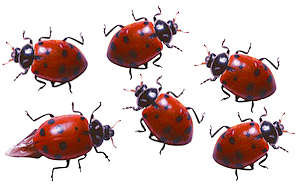
 |
|
 Beneficials, Predators and Parasites Predators and Parasites are two categories of insects used as beneficals. Both do a tremendous job of controlling insect pests in the landscape, and should be welcomed into gardens. We encourage you to learn more about and use these non-toxic, earth-friendly insect controls. To introduce the good insect to your garden: 1. Provide water. 2. Provide shelter - leaves under trees or shrubs may provide shelter during adverse conditions. 3. Grow a variety of plants. 4. If using insecticides, stick with BT, Neem oil, dormant oils, and insecticidal soaps. Lady Beetle "Ladybug" Both the adult and larvae destroy aphids, mites, mealybug, scale, and other tiny insect pests. The lifespan is about 28 days in an immature stage and 11 months as an adult. Eggs are laid on the underside of leaves of infested plants. Lacewings The larvae of these beautiful insects are its only predatory form. Lacewing larvae attack immature scales, mealybugs, whiteflies, red spider mites, thrips, leafhoppers, and aphids. Several generations may occur in one calendar year. Dragonflies Able to catch as many as 100 mosquitoes in a day, dragonflies also like beetles, moths, flies, and termites. They prefer to be around water (a garden pond) or a water source. In the fall, they lay their eggs on water plants or on the water surface. Praying Mantis Arguably the best-known beneficial insect, the praying mantis' contribution is relative in that it devours many garden bugs, but does not differentiate between good and bad. The egg cases may be found on tree twigs and in the field. Each case will produce hundreds of young. Braconid Wasp These wasps lay their eggs on the tomato hornworm, eventually killing it and producing more beneficial wasps in the process. Beneficial Nematodes Tiny parasites that are good news for the gardener, nematodes will control armyworms, rootworms, fleas, fungus gnats, stem borers, root weevil, cutworms, and billbugs. They are environmentally safe and harmless to humans and all other warm blooded animals, nor will they harm fish or plants. Apply in spring and fall when the soil contains insect larvae. Results usually take two to three weeks. Most gardeners will need to apply each year. Each spray will introduce hundres of millions of nematodes. Birds Don't forget that birds are beneficials - insectivores eat their weight in insects several times a day. DID YOU KNOW:
There are many more very good predators and parasites in the world of insects. Listed above are just a few of the better-known. Garden Supply offers a handout available in stores now. |
|
 Summer Hours Our Main Street stores are open from 9 a.m. to 6 p.m. daily. Don't miss our Islands of Savings Celebration! |